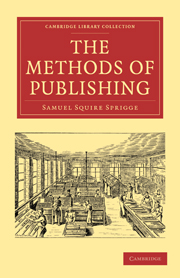Book contents
- Frontmatter
- Contents
- THE SOCIETY OF AUTHORS (INCORPORATED)
- PREFACE
- CHAPTER I LITERARY PROPERTY
- CHAPTER II THE VALUE OF ITS DIFFERENT FORMS
- CHAPTER III SALE, OUT-RIGHT AND LIMITED
- CHAPTER IV THE HALF-PROFIT SYSTEM
- CHAPTER V THE ROYALTY SYSTEM
- CHAPTER VI PUBLISHING ON COMMISSION
- CHAPTER VII ADVERTISEMENT
- CHAPTER VIII AUTHOR'S CORRECTIONS
- CHAPTER IX AGREEMENTS, MORE OR LESS
- CHAPTER X REMAINDER-SALES
- CHAPTER XI CONCLUDING REMARKS
- APPENDIX: THE SOCIETY OF AUTHORS. (INCORPORATED.)
- CONDITIONS OF MEMBERSHIP
CHAPTER I - LITERARY PROPERTY
Published online by Cambridge University Press: 29 August 2010
- Frontmatter
- Contents
- THE SOCIETY OF AUTHORS (INCORPORATED)
- PREFACE
- CHAPTER I LITERARY PROPERTY
- CHAPTER II THE VALUE OF ITS DIFFERENT FORMS
- CHAPTER III SALE, OUT-RIGHT AND LIMITED
- CHAPTER IV THE HALF-PROFIT SYSTEM
- CHAPTER V THE ROYALTY SYSTEM
- CHAPTER VI PUBLISHING ON COMMISSION
- CHAPTER VII ADVERTISEMENT
- CHAPTER VIII AUTHOR'S CORRECTIONS
- CHAPTER IX AGREEMENTS, MORE OR LESS
- CHAPTER X REMAINDER-SALES
- CHAPTER XI CONCLUDING REMARKS
- APPENDIX: THE SOCIETY OF AUTHORS. (INCORPORATED.)
- CONDITIONS OF MEMBERSHIP
Summary
Publishing is the process by which an author brings his work before the public, for whom it has been written, and from whom he expects to reap a return in money, fame, or both.
A man's literary work is, though the fact is too often forgotten, his personal property, which he may use absolutely as he chooses, over which he alone has control, to sell, to lease, to lend, or to give away. Among the various methods of publishing, there may be included any process, that can be devised for treating such property with a view to obtaining by publicity, a return in money, or in repute, for the labour expended. In fact the schoolboy who stated that “ Esau wrote some fables and sold the copyright for a bottle of potash,” although hazy as to facts, was merely quoting an agreement, which, by comparison with the actual remuneration frequently received by a modern author, shows that Æsop made by no means a bad bargain.
There are customary methods for dealing with houses or with land, and there are customary methods for dealing with Literary Property. Here the similarity in method enas. Houses and land are placed by their owner at the public disposal according to methods approved by law, and founded upon long custom and experience; moreover, such disposal is usually, almost invariably, undertaken with legal formality if not under legal advice. Literary Property is dealt with by methods approved neither by equity nor by good sense, founded neither upon custom, nor experience, and protested against from time immemorial by authors.
- Type
- Chapter
- Information
- The Methods of Publishing , pp. 9 - 15Publisher: Cambridge University PressPrint publication year: 2010First published in: 1890

